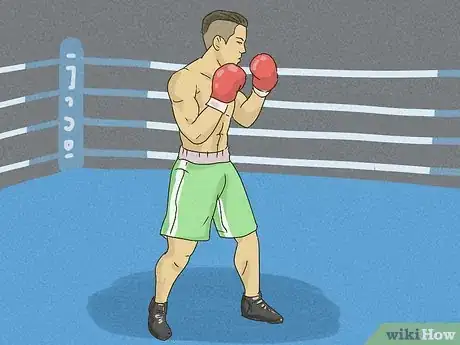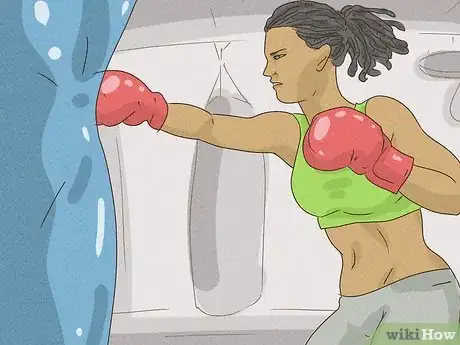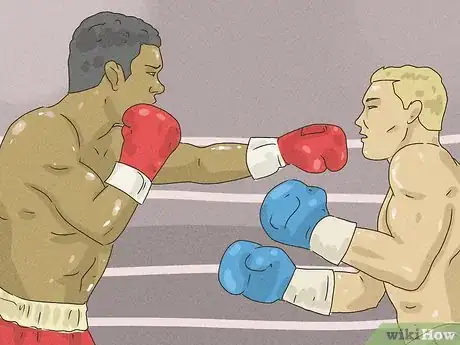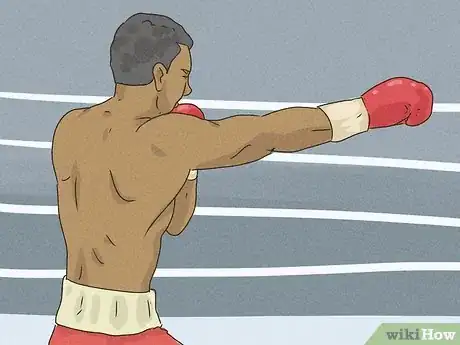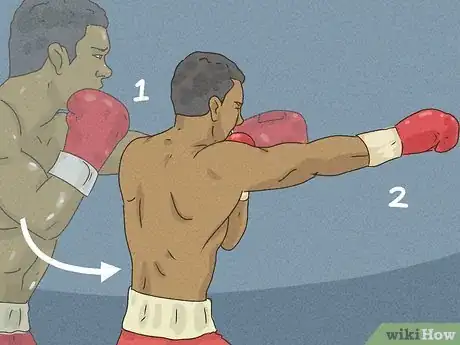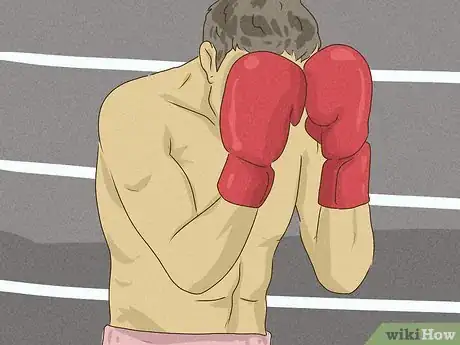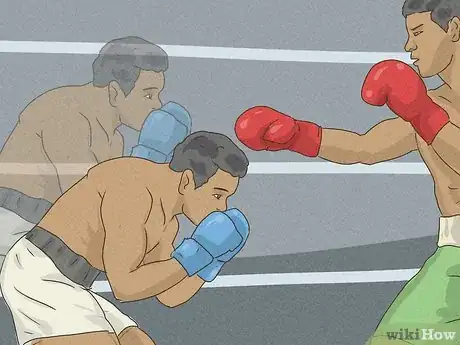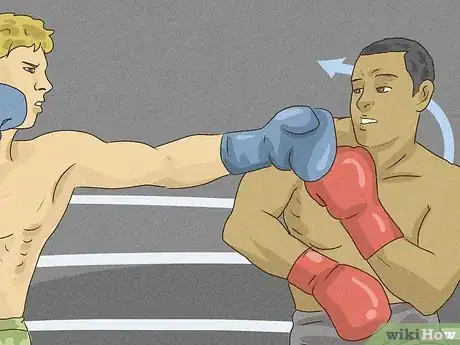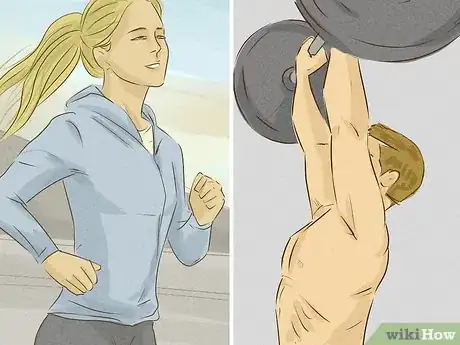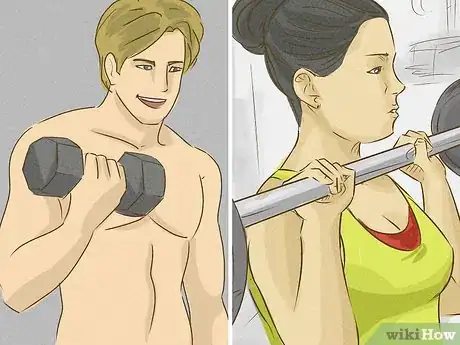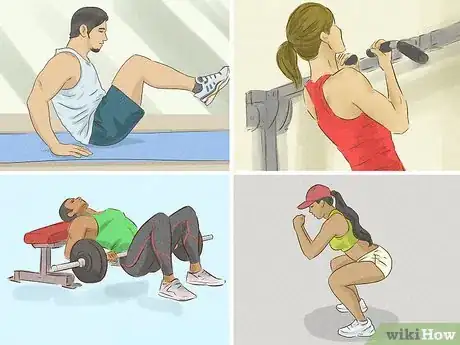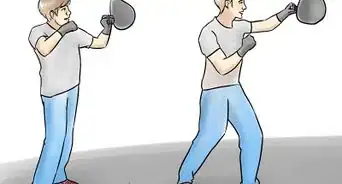This article was co-authored by David Engel. David Engel is a Muay Thai Instructor and Self Defense Trainer based in the San Francisco Bay Area. With over 15 years of martial arts instruction and training experience, David runs California Martial Athletics with co-owner Joe Chernay. He has created and maintained martial arts programs at Rise Combat Sports in San Francisco and Round 5 Martial Arts Academy in San Leandro, with a mission to provide students with a level of comfort and competency that manifests both within and outside the martial arts context. He is also a registered cornerman for amateur and pro competitors under the IKF (International Kickboxing Federation). David was the youngest apprentice instructor of the Thai Boxing Association of America under Ajarn Chai Sirisute (2009), and was a top-ranked amateur competitor in his weight class (127-130 lb) in California between 2013 and 2015.
There are 8 references cited in this article, which can be found at the bottom of the page.
wikiHow marks an article as reader-approved once it receives enough positive feedback. In this case, several readers have written to tell us that this article was helpful to them, earning it our reader-approved status.
This article has been viewed 457,717 times.
Boxing is one of the most physically demanding sports. It requires a blend of power and quickness, plus excellent overall physical conditioning. If you'd like to start boxing, it's important to develop a good workout strategy in order to develop your strength and cardio system. You'll also need to pick up the basics of boxing, including learning some standard footwork plus offensive punches and defensive moves. If you’re a boxing novice, try joining a boxing gym where you can train and spar with more experienced boxers and boxing coaches.
Steps
Learning Boxing Fundamentals
-
1Develop a stable stance for effective defense. A strong, comfortable stance will enable you to unleash powerful punches and swiftly evade blows from your opponent. Always keep your feet shoulder-width apart and your weight evenly balanced on both feet.[1] Most of your weight should be on your back foot.
- Keep your elbows in and your hands up, with your left under your cheek and your right under your chin. Keep your chin down at all times.
- If you're a right-handed fighter, the proper stance is to have your left foot in front of you, pointing away from your opponent at a 45° angle. Your left heel should line up with your right toe. If you’re left-handed, reverse the stance and lead with your right foot.
-
2Stand on your toes and keep moving to practice your footwork. Good footwork in the ring will help you evade your opponents and move in quickly for a strike. Focus on making quick movements in the ring, pivoting and sliding with the balls of your feet when necessary. Avoid putting weight on your heels when moving into the boxing ring. This will move your center of gravity backwards ad make it easier for your opponent to knock you down.[2]
- Keep your spine straight when you’re moving around in the ring. Keep your upper body relaxed so it won’t restrict your legs’ movement.
- Also, never cross-step (put one foot in front of the other when you step forward). This can put you in an unbalanced, indefensible position.
Advertisement -
3Tape your hands every time you spar. Wrapping your hands will protect them from being cut or seriously bruised while you box. Hook your thumb and pull the tape down and wrap it around your wrist 3 times. Then pull the tape up and wrap it around your hands 3 times.[3]
- Bring the tape back down under the pad of your thumb and make “X” shapes in the gaps between your fingers. Do this starting with your pinky and ring fingers. Pull the tape through each gap, then twist it across the bottom of your hand along the upper pads.
- Cross the tape over the back of your hand from right to left and then go underneath. Repeat the process for the other gaps.
- When you've completed that, wrap around your thumb once and then around the back of your hand. Wrap your thumb again and then pull the tape across your palm. From here, wrap your knuckles 3 times and end by wrapping your wrist once. Wrap is really useful for keeping the position of your hand in place whilst your hand is in a boxing glove as well as absorbing moisture such as sweat.
Developing Offensive Punches
-
1Practice punching on a bag to develop proper form. Whether shadow-boxing or using a speed bag or heavy bag, new boxers must concentrate on using proper form when unleashing a blow. Using proper form means that you’ll need to develop a good sense of balance so that you’re not thrown off balance by throwing a punch. Also, practice keeping your hands in front of your face and returning to this defensive position after throwing a punch.[4]
- Before punching, keep your hands close to your face and your elbows tight against your body.
- Put your weight into the punches you throw, and follow through with each punch. This will help you land punches effectively and accurately on your opponent’s head or torso.
-
2Jab at your opponent to keep them at a distance. Jabbing is a basic punch which you’ll usually do with your weaker front hand. The jab is a short punch. To jab, drive your fist straight into your opponent’s face or torso.[5]
- To maximize the effectiveness of the jab, professional boxers twist their arm and wrist just before making contact with their opponent.
-
3Throw a cross punch to counter punch a jab. As opposed to a jab, which is thrown straight in front of the body, deliver a cross punch by jabbing your dominant hand in a slightly upward motion across your body. If your opponent throws a left jab at you, they’ll leave themself open for your right hook. Keep your weight on the balls of your feet, and aim your punch across your body towards the right side of your opponent’s torso or face.[6]
- Use the cross on its own to counter a jab, or put the jab and cross together for a 1-2 combo.
- The shoulder helps power the cross punch. Also pay attention to your feet when throwing a cross. As you throw the punch, move your body weight from your rear foot up to your front foot.
-
4Throw a hook when you have time for a slower, powerful punch. The hook can be delivered to the head or body of the opponent. Lean your body to the side that you plan to hit from, and circle your arm around to punch the opponent in the unprotected side of their head or body. The hook is often used in combination with other punches. [7]
- The hook’s sweeping delivery is its chief drawback, as it can leave you susceptible to a counterpunch. So, if you and your opponent are exchanging swift jabs back and forth, this isn’t the time to wind up for a hook.
-
5Use an uppercut to seriously damage your opponent. The uppercut is an upward blow unleashed by either hand that is highly effective when in close quarters. Throw an uppercut when you’re close to your opponent’s body. To uppercut, lower your arm to about waist-height, then swing it upward in an explosive burst. Aim to his your opponent squarely on their chin.[8]
- Don’t try to throw an uppercut form more than 1 foot (0.30 m) away, or you may miss and leave yourself open to a counter-attack to your body.
-
6Combine punches to hit an opponent multiple times in a row. After they become adept at delivering a variety of punches, fighters usually develop combinations, in which they release a devastating flurry of blows on their opponent. The first combination most boxers learn is the 1-2 combo (a jab followed by a cross). Try putting together different combos of your own. Rely on building combos around punches that you feel good throwing.[9]
- Another effective combo adds a hook to the 1-2 combo. If you're right-handed, this would be a left jab followed by a right cross and ending with a left hook.
Picking up Defensive Moves
-
1Learn to take a punch to increase your longevity in the ring. Boxing isn't all about throwing punches. Minimizing your opponent's blows is a vital part of the game, too. To take a punch, relax your body and keep eye contact with your opponent. This will help you figure out where they are planning to land their next punch. If your opponent is aiming their punches for your body, tighten up your core muscles and absorb the punches.[10]
- Develop an effective boxing defense by mixing together various methods of deflecting, blocking, and dodging your opponent’s punches.
-
2Parry your opponent’s punches by knocking them away. After keeping your gloves up and chin down, the parry is probably the most basic defensive technique in boxing. To parry, hold your hands at the level of your face and, when your opponent throws a punch, move your hand to strike your opponent’s gloves and misdirect the punch.[11]
- You’ll need to move fast to parry quick punches like jabs and crosses.
-
3Slip punches to dodge a punch altogether. The slip is performed by sharply rotating your hips and shoulders as your rival throws a punch aimed at your head. Also turn your chin sharply in the same direction that you’re turning your body. This will cause your opponent to miss their target (your head) altogether. It’s more difficult to slip punches directed at your body, since it presents a larger target. Instead, try to block blows aimed at your body.[12]
- Slipping a punch works best if your opponent throws a punch from at least 2 feet (0.61 m) away.
-
4Block punches that your opponent throws at you. When blocking a punch, do not try moving your entire body out of the way to avoid the punch. Instead, absorb the impact with your gloves. Start with your gloves held defensively in front of your face, and move one or both gloves to defend an area of your body that your opponent is trying to punch.[13]
- Be aware that blocking punches will gradually tire out your hands, and may reduce the effectiveness of your punches.
-
5Bob and weave to present a difficult target to your opponent. The bob is executed by bending the legs to avoid a high blow (e.g., a hook to the head). Bobbing is almost like ducking, although you’ll keep your head up and your eyes on your opponent. Follow up the bob with a weave to evade your opponent. To weave, arch your body just out of range of your opponent's extended glove and straighten back up.[14]
- While the bob and the weave are technically separate defensive moves, they’re commonly paired together.
- After weaving, strike out at your opponent with a jab.
- To get better at bobbing and weaving, do exercises that will improve your balance and your leg strength, like jump squats, sprinting, and skipping rope.[15]
-
6Roll your body to deflect your opponent’s punches. When you roll with punches, you won’t dodge them altogether. Instead, you’ll move your body away from your opponent’s glove to reduce the force of each punch. Press your gloves to your forehead, hold your elbows in against your body, and keep your chin against your chest.[16] When your opponent throws punches at you, roll your hips and torso to the right or left to deflect hits.
- So, if your opponent swings at you with a right jab, swing your upper body to the left. While the jab will still strike you, its force will be much weaker than if you hadn’t rolled away from the blow.
- Rolling provides little protection against side-body blows but is an effective defense against a barrage of punches, as your gloves and forearms absorb most of the impact.
Committing to a Comprehensive Training Regimen
-
1Start training at least 3 months before you begin boxing. Some boxing experts suggest that beginners train for 3 to 6 months before ever entering a ring. This allows fledgling fighters to reach peak physical condition and perfect basic techniques before engaging in their first match. You can put together your own training regimen, or join a gym which focuses on developing boxers.[17]
- Most physical-conditioning programs for boxers can be broken down into 3 categories: cardiovascular, core exercises, and weight training.
-
2Work on cardiovascular exercises to develop high endurance. Boxers need to not only have great endurance capabilities but also must summon short bursts of power at key moments in a bout. To meet these physical requirements, boxers will vary their cardio training programs. Try to do at least 30 minutes of cardio training every day that you work out. Cardio can include things like jumping rope, running (indoors or outdoors), cycling, swimming, and training on stair-climbing machines.[18]
- For example, boxers will vary the pace of their endurance-building runs to include brief, all-out sprints. This simulates the physical demands and chaos of fighting.[19]
- Long-distance running will help you build endurance, and it will also help you recover more quickly between rounds in a boxing match.[20]
- Fatigued fighters tend to drop their hands and leave their heads exposed. They also can't produce the energy to effectively counterpunch in late rounds of a bout.
-
3Weight train to build your upper-body muscles. Weightlifting helps new boxers build strength and punching power. Your chest, shoulders, and arms are of particular importance. The key in weight training for boxers is to develop the strength needed for explosive punches. This means doing 6 to 8 reps of each exercise with the heaviest weight you can handle. Do 3 sets of each and vary the exercises so your muscles don't plateau. Alternate days between core and weight training.
- Upper-chest exercises include the flat bench press and dumbbell flies.
- Target your shoulder muscles with dumbbell military presses and lateral raises.
- Biceps curls and triceps kickbacks help build upper arm strength needed to increase punching power.
-
4Perform core exercises to build up overall strength and dexterity. Boxers generate much of their power from the core of the body. Some of the most effective exercises include chin-ups and pull-ups, crunches, squats, and thrusts. Do 3 sets of each with 1-minute breaks in between exercises. Chin-ups and pull-ups should be done until you can't do any more. Do 20 reps of the other exercises.
- By performing exercises that involve many muscle groups, a prizefighter can build a powerful core that forces all parts of the body to work cohesively.
Expert Q&A
Did you know you can get expert answers for this article?
Unlock expert answers by supporting wikiHow
-
QuestionWhat exercises should I do to improve my footwork for boxing?
 David EngelDavid Engel is a Muay Thai Instructor and Self Defense Trainer based in the San Francisco Bay Area. With over 15 years of martial arts instruction and training experience, David runs California Martial Athletics with co-owner Joe Chernay. He has created and maintained martial arts programs at Rise Combat Sports in San Francisco and Round 5 Martial Arts Academy in San Leandro, with a mission to provide students with a level of comfort and competency that manifests both within and outside the martial arts context. He is also a registered cornerman for amateur and pro competitors under the IKF (International Kickboxing Federation). David was the youngest apprentice instructor of the Thai Boxing Association of America under Ajarn Chai Sirisute (2009), and was a top-ranked amateur competitor in his weight class (127-130 lb) in California between 2013 and 2015.
David EngelDavid Engel is a Muay Thai Instructor and Self Defense Trainer based in the San Francisco Bay Area. With over 15 years of martial arts instruction and training experience, David runs California Martial Athletics with co-owner Joe Chernay. He has created and maintained martial arts programs at Rise Combat Sports in San Francisco and Round 5 Martial Arts Academy in San Leandro, with a mission to provide students with a level of comfort and competency that manifests both within and outside the martial arts context. He is also a registered cornerman for amateur and pro competitors under the IKF (International Kickboxing Federation). David was the youngest apprentice instructor of the Thai Boxing Association of America under Ajarn Chai Sirisute (2009), and was a top-ranked amateur competitor in his weight class (127-130 lb) in California between 2013 and 2015.
Muay Thai Instructor & Self Defense Trainer
-
QuestionWhat do I need to start boxing?
 Community AnswerYou need some basic supplies, such as gloves and a punching bag. You also need good muscles, a healthy diet, positive motives, and a good attitude.
Community AnswerYou need some basic supplies, such as gloves and a punching bag. You also need good muscles, a healthy diet, positive motives, and a good attitude. -
QuestionThere are no boxing clubs in my area. What can I do?
 Community AnswerPractice at home. Buy a bag and look up videos to help you. If you don't have a bag, shadow box.
Community AnswerPractice at home. Buy a bag and look up videos to help you. If you don't have a bag, shadow box.
Things You'll Need
- Gloves
- Boxing trunks
- Headgear
- Mouth guard
- Heavy bag
- Hand tape
- Boxing boots
References
- ↑ http://www.mmarevolution.com/learn-how-to-box/
- ↑ https://www.expertboxing.com/boxing-techniques/boxing-footwork/10-boxing-footwork-tips
- ↑ http://www.boxing-for-life.com/Boxing-basics.html
- ↑ http://www.boxing-for-life.com/how-to-punch.html
- ↑ http://www.saddoboxing.com/learn.html
- ↑ http://www.boxing-for-life.com/how-to-punch.html
- ↑ http://www.saddoboxing.com/learn.html
- ↑ http://www.mmarevolution.com/learn-how-to-box/
- ↑ http://www.saddoboxing.com/learn.html
- ↑ https://www.expertboxing.com/boxing-strategy/boxing-defense/how-to-take-punches-better
- ↑ http://www.boxing-for-life.com/boxing-defense.html
- ↑ http://www.boxing-for-life.com/boxing-defense.html
- ↑ http://www.boxing-for-life.com/boxing-defense.html
- ↑ http://www.boxing-for-life.com/boxing-defense.html
- ↑ David Engel. Muay Thai Instructor & Self Defense Trainer. Expert Interview. 5 May 2020.
- ↑ http://www.boxing-for-life.com/boxing-defense.html
- ↑ http://www.mmarevolution.com/learn-how-to-box/
- ↑ David Engel. Muay Thai Instructor & Self Defense Trainer. Expert Interview. 5 May 2020.
- ↑ David Engel. Muay Thai Instructor & Self Defense Trainer. Expert Interview. 5 May 2020.
- ↑ David Engel. Muay Thai Instructor & Self Defense Trainer. Expert Interview. 5 May 2020.
About This Article
To properly box, stand with your non-dominant foot in front of you, with the toes of your dominant foot lined up with the heel of your front foot. Keep most of your weight on your back foot, and hold your hands up with your elbows in towards your body. Always keep your chin down, and try to stay moving so your opponent will have a harder time hitting you. When you see an opening, jab out with your boxing glove to strike your opponent, and use your gloves to block their hits as well. Keep reading to learn the names of the different punches in boxing!
